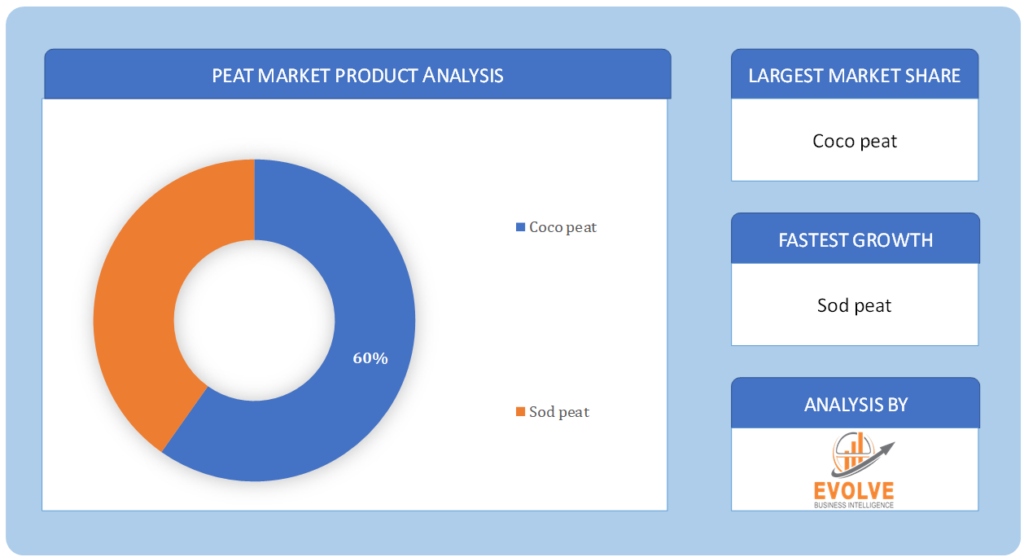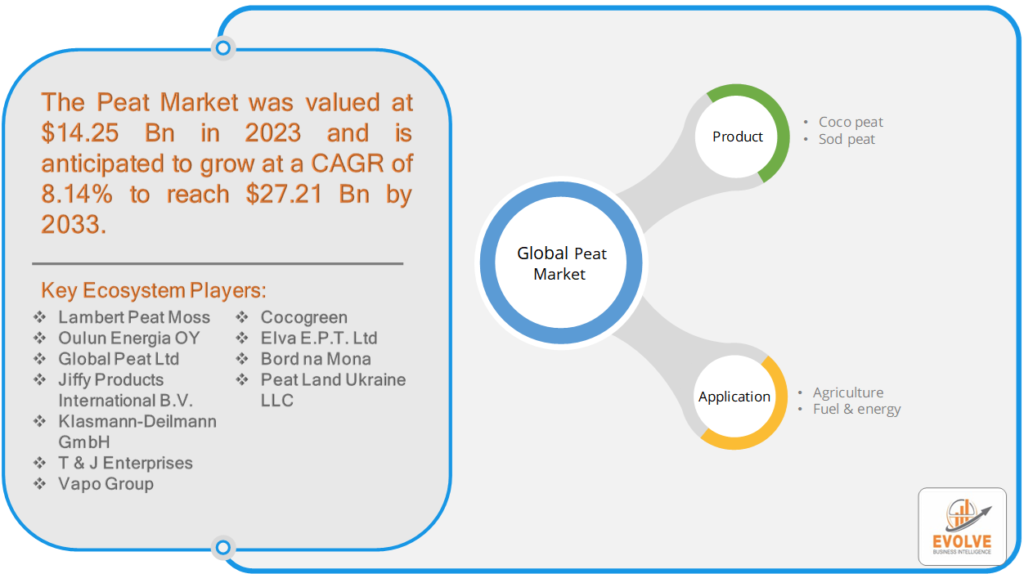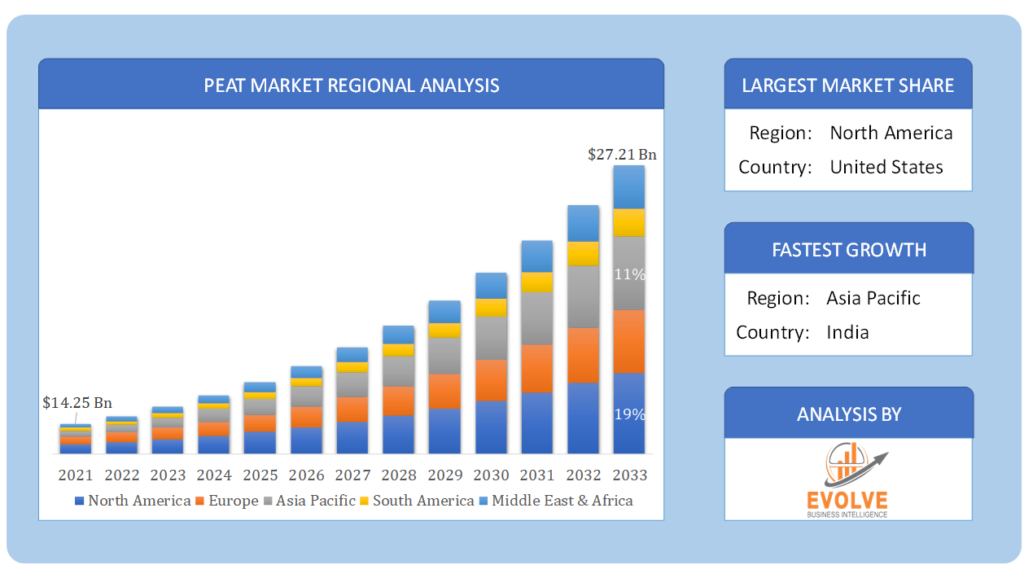Peat Market Overview
The Peat Market Size is expected to reach USD 27.21 Billion by 2033. The Peat Market industry size accounted for USD 14.25 Billion in 2023 and is expected to expand at a compound annual growth rate (CAGR) of 8.41% from 2023 to 2033. Peat Market typically refers to the economic activity and trade surrounding peat, which is a type of organic material commonly found in wetlands and bogs. Peat is composed of decomposed plant matter and is used for various purposes, mainly as a fuel source and as a soil conditioner.
Peat is used as a traditional source of fuel in some regions for heating and cooking purposes. However, its use as a fuel has raised concerns due to environmental issues like carbon emissions and degradation of peatlands.
Global Peat Market Synopsis
The COVID-19 pandemic has significant impacts on various industries and markets worldwide, including the peat market. Peat extraction and processing operations may have been affected by lockdowns, restrictions, and workforce shortages due to the pandemic. This could have led to reduced production and potential supply chain disruptions. The pandemic highlighted the importance of environmental conservation and sustainability. As a result, there might have been an increased focus on alternatives to peat in the horticulture industry due to concerns about peatland degradation and carbon emissions.International trade and export of peat products may have been impacted by travel restrictions, border closures, and changes in shipping logistics during the pandemic.
Peat Market Dynamics
The major factors that have impacted the growth of Peat Market are as follows:
Drivers:
- Agriculture and Horticulture
Peat is a popular soil amendment in agriculture and horticulture. Its ability to improve soil structure, water retention, and nutrient-holding capacity makes it valuable for enhancing soil fertility and productivity. When mixed with existing soils, peat can improve their overall quality, making them more suitable for plant growth. The demand for peat in agriculture and horticulture as a soil amendment and growing medium is a significant driver for the peat market. Peat’s ability to improve soil structure, water retention, and nutrient availability makes it a popular choice among gardeners, farmers, and greenhouse operators.
Restraint:
- Regulatory Restrictions
The extraction of peat from natural peatlands can have adverse environmental impacts. Peatlands are vital ecosystems that play a significant role in carbon sequestration and biodiversity conservation. Peat extraction can lead to habitat destruction, release of greenhouse gases, and disruption of delicate ecosystems. Peatlands store vast amounts of carbon dioxide accumulated over thousands of years. When peat is extracted or drained for commercial use, the stored carbon is released into the atmosphere, contributing to climate change. Some countries have imposed regulations and restrictions on peat extraction due to its environmental impact. These regulations can limit the supply of peat-based products and increase production costs for peat manufacturers.The increasing awareness of environmental issues has led to a growing demand for sustainable alternatives to traditional peat. Peat substitutes, such as coir (coco peat), compost, wood fiber, and other renewable materials, are gaining popularity, reducing the demand for traditional peat products.
Opportunity:
- Peatland Restoration and Conservation Projects
The increasing awareness of the environmental impact of traditional peat extraction has created a demand for sustainable alternatives. Companies that focus on providing eco-friendly peat substitutes like coir (coco peat), compost, wood fiber, and other renewable materials have an opportunity to capture a growing market segment. As awareness of peatland conservation grows, there are opportunities for businesses to participate in peatland restoration and conservation projects. These initiatives aim to restore degraded peatlands, protect biodiversity, and mitigate climate change by preserving peat carbon stocks.Expanding into new geographical markets and exploring different application areas for peat products can present opportunities for growth. Companies can diversify their offerings to cater to various industries such as agriculture, landscaping, horticulture, and water filtration. Collaborating with organizations, NGOs, and governments working on peatland conservation and restoration can lead to mutually beneficial partnerships and opportunities for sustainable business development.
Peat Market Segment Overview
By Product Type
 Based on Product Type, the market is segmented based on Coco peat and Sod peat. Coco peat is derived from the fibrous husk (mesocarp) surrounding the coconut shell. It is a byproduct of the coconut industry. Coco peat is a lightweight, spongy, and fibrous material. It has excellent water retention capabilities and provides good aeration to plant roots. Coco peat is pH neutral and has a high cation exchange capacity (CEC), which helps in nutrient retention and release. Coco peat is widely used in horticulture and gardening as a peat substitute. It is used as a component in potting mixes and growing media for seed starting, container gardening, and greenhouse production. It is an environmentally friendly alternative to traditional peat, as it is a renewable resource and does not require the extraction of peat from wetlands.
Based on Product Type, the market is segmented based on Coco peat and Sod peat. Coco peat is derived from the fibrous husk (mesocarp) surrounding the coconut shell. It is a byproduct of the coconut industry. Coco peat is a lightweight, spongy, and fibrous material. It has excellent water retention capabilities and provides good aeration to plant roots. Coco peat is pH neutral and has a high cation exchange capacity (CEC), which helps in nutrient retention and release. Coco peat is widely used in horticulture and gardening as a peat substitute. It is used as a component in potting mixes and growing media for seed starting, container gardening, and greenhouse production. It is an environmentally friendly alternative to traditional peat, as it is a renewable resource and does not require the extraction of peat from wetlands.
By End User
Based on End Users, the market has been divided into Agriculture and Fuel & energy. Peat is used in agriculture primarily as a soil amendment and conditioner. Peat’s ability to improve soil structure and porosity makes it valuable for enhancing soil fertility and drainage. It creates a favorable environment for plant root growth and nutrient uptake. Peat has excellent water-holding capacity, which helps retain moisture in the soil during dry periods, reducing the need for frequent irrigation. Peat is a common component in potting mixes and seed starting media. Its light and airy texture promote successful seed germination and seedling development.
Global Peat Market Regional Analysis
Based on region, the global Peat Market has been divided into North America, Europe, Asia-Pacific, the Middle East & Africa, and Latin America. North America is projected to dominate the use of the Peat Market followed by the Asia-Pacific and Europe regions.
 North America Market
North America Market
Canada and the United States are major producers and consumers of peat products in North America. Peat is used in various applications, including horticulture, agriculture, and landscaping. The use of peat substitutes and the adoption of sustainable practices have been on the rise in response to environmental concerns.
Asia-Pacific Market
As urbanization continues in countries like India, China, and Southeast Asian nations, there is a growing interest in gardening, landscaping, and urban agriculture. This has led to increased demand for peat-based products like potting mixes and growing media. The horticulture and gardening industry in the Asia-Pacific region has been experiencing significant growth. As people become more aware of the benefits of gardening and green spaces, the demand for peat products for use in home gardens, public parks, and commercial nurseries has increased. Agriculture and Land Reclamation: Some countries in the region have been utilizing peat for agricultural purposes and land reclamation projects. Peat’s ability to improve soil fertility and water retention makes it valuable for these applications.
Competitive Landscape
The global Peat Market is highly competitive, with numerous players offering a wide range of software solutions. The competitive landscape is characterized by the presence of established companies, as well as emerging startups and niche players. To increase their market position and attract a wide consumer base, the businesses are employing various strategies, such as product launches, and strategic alliances.
Prominent Players:
- Lambert Peat Moss
- Oulun Energia OY
- Global Peat Ltd
- Jiffy Products International B.V.
- Klasmann-Deilmann GmbH
- T & J Enterprises
- Vapo Group
- Cocogreen
- Elva E.P.T. Ltd
- Bord na Mona
- Peat Land Ukraine LLC
Key Development
In April 2022, Neova introduces a DNA barrier accelerator, which restores the skin while acting as a barrier to fight symptoms of damage. This powerful mixture protects the skin, enhances repair, retains moisture, and soothes the skin.
In November 2021, Suntory Holdings and Beam Suntory, the producers of Teacher’s, Laphroaig, and Bowmore Scotch whiskies, announce the beginning of a new Peatland Water Sanctuary initiative.
Scope of the Report
Global Peat Market, by Product
- Coco peat
- Sod peat
Global Peat Market, by Application
- Agriculture
- Fuel & energy
Global Peat Market, by Region
- North America
- US
- Canada
- Mexico
- Europe
- UK
- Germany
- France
- Italy
- Spain
- Benelux
- Nordic
- Rest of Europe
- Asia Pacific
- China
- Japan
- South Korea
- Indonesia
- Austalia
- Malaysia
- India
- Rest of Asia Pacific
- South America
- Brazil
- Argentina
- Rest of SouthAmerica
- Middle East &Africa
- Saudi Arabia
- UAE
- Egypt
- SouthAfrica
- Rest of Middle East & Africa
| Parameters | Indicators |
|---|---|
| Market Size | 2033: $27.21Billion |
| CAGR | 8.41% CAGR (2023-2033) |
| Base year | 2022 |
| Forecast Period | 2023-2033 |
| Historical Data | 2021 |
| Report Coverage | Revenue Forecast, Competitive Landscape, Growth Factors, and Trends |
| Key Segmentations | Product Type, Application |
| Geographies Covered | North America, Europe, Asia-Pacific, Latin America, Middle East, Africa |
| Key Vendors | Lambert Peat Moss, Oulun Energia OY, Global Peat Ltd, Jiffy Products International B.V., Klasmann-Deilmann GmbH, T & J Enterprises, Vapo Group, Cocogreen, Elva E.P.T. Ltd, Bord na Mona |
| Key Market Opportunities | • Growing Demand for Sustainable Alternatives |
| Key Market Drivers | • Agriculture and Horticulture • Technological Advancements |
REPORT CONTENT BRIEF:
- High-level analysis of the current and future Peat Market trends and opportunities
- Detailed analysis of current market drivers, restraining factors, and opportunities in the future
- Peat Market historical market size for the year 2021, and forecast from 2023 to 2033
- Peat Market share analysis at each product level
- Competitor analysis with detailed insight into its product segment, Government & Defense strength, and strategies adopted.
- Identifies key strategies adopted including product launches and developments, mergers and acquisitions, joint ventures, collaborations, and partnerships as well as funding taken and investment done, among others.
- To identify and understand the various factors involved in the global Peat Market affected by the pandemic
- To provide a detailed insight into the major companies operating in the market. The profiling will include the Government & Defense health of the company’s past 2-3 years with segmental and regional revenue breakup, product offering, recent developments, SWOT analysis, and key strategies.






